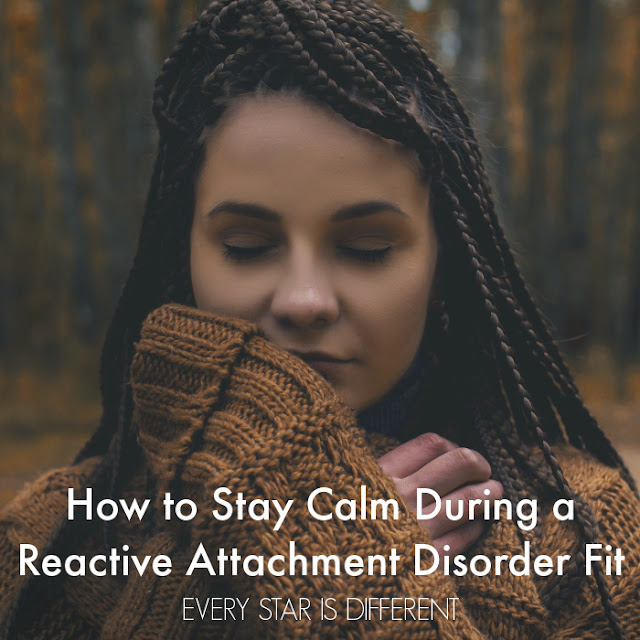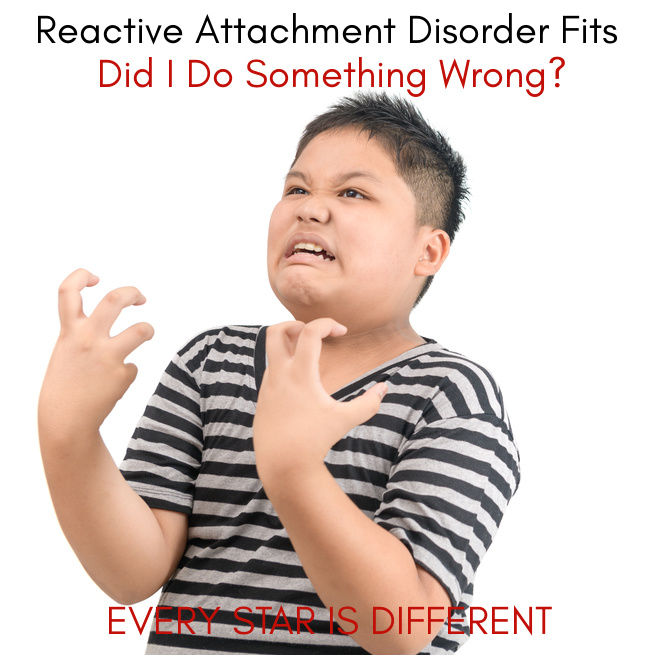Warning: This post contains information about behaviors at home related to Reactive Attachment Disorder and may be triggering to some.
I received an e-mail from a reader earlier this week. She wrote:
"How do you stay calm and help your child through this bout of frustration/anger when she won't respond to anything you suggest or try except with a growl or refusal?
How do you cope with a child who gets so angry she throws things or tears her papers or tries to hurt others, [and when] she screams and glares at you with such malice and possible hatred?
Raising a child with Reactive Attachment Disorder is HARD.
It is perfectly normal for a parent to wonder how in the world other families manage these circumstances, especially when you are just trying to survive.
Today I'm excited to share how I work my way through these scenarios, remaining calm during a Reactive Attachment Disorder fits.
For the purpose of this post, I first want to state that Reactive Attachment Disorder fits are very different than autism meltdowns or scenarios in which children are on sensory overload.
I am using the word "fit" because that is the word we use at home for these scenarios. You may prefer to call them something different, and that's completely okay.
Other words I have heard used in different scenarios include disruptions, aggressions, threats, behaviors, etc.
Moving on with the post...
How To Stay Calm During a Reactive Attachment Disorder Fit
1. Remember you've tried NOT being calm and it only made things worse.
It is completely normal for a caregiver of a child with Reactive Attachment Disorder to try EVERYTHING to make things better at home. This includes the good, the bad, and everything in between.
You desperately want to find something that works to make the madness stop, and are willing to do whatever it takes.
There comes a point when you either hit a breaking point, or pause to analyze how your responses to behaviors affect the situation.
In both situations you realize NOT remaining calm does a number on both of you and only causes harm.
Sometimes all it takes is remembering what happened when you weren't calm.
2. Avoid personalizing the situation.
During a Reactive Attachment Disorder fit, you are most likely the target. This means all of the anger and rage is directed at you.
Your child may say extremely harmful and unkind words, and at times threaten you.
Your child may try to destroy property.
Your child may try to harm you or others.
It is so easy to take these situations personally and in turn either begin to feel negative feelings that are just as strong towards the child, or blame yourself, constantly thinking you're not good enough.
The truth is, Reactive Attachment Disorder fits aren't about the caregiver AT ALL.
They are all about the child and how the child thinks and feels about herself.
She will do ANYTHING to push a caregiver away to protect herself and the caregiver from those thoughts and feelings, until the feelings get so big, she can't hold back anymore.
Fits usually start when a child with Reactive Attachment Disorder wants what she wants when she wants it.
Knowing these facts helps me understand that the things Sunshine and Princess say and do during fits are only about protecting me from themselves, even though it may not look or feel that way in the moment.
And if I ever doubt myself, all I have to do is look and see how Sunshine and Princess did in settings outside of the home, whether it be public school, a day program, visits with respite workers, or residential.
Let's just say, without going into too much detail, behaviors were much worse.
As hard as it can be, take yourself out of the thought equation during fits. Focus on safety, not personal feelings. Taking these steps definitely helps stay calm during the worst behaviors.
3. Choose NOT to let Reactive Attachment Disorder fits ruin your day.
Early on in our journey as caregivers of children with Reactive Attachment Disorder, it was so easy to allow fits to ruin the day. As we chose to allow more and more days to be "ruined" by behaviors, negative feelings would build up, which then led to feeling completely paralyzed.
She would say and do things that were not cool or okay.
I would then respond in negative ways as a parent and feel horrible about myself for the rest of the day.
There came a point, when I became fed up with my days being sabotaged by these interactions.
Princess was having a rough time. I decided to say the following.
"You can choose to ruin your day, but you are not going to ruin mine. I am going to choose to have a great day no matter what choices you decide to make. You can choose the type of day you want to have."
I will fulfill my role as caregiver during the day's schedule, but if there is a Reactive Attachment Disorder fit, whether it lasts five minutes, an hour, or four hours, I'll do what I need to do to keep everyone safe, process emotions with all in the home, and then move on with my day.
Yes, Reactive Attachment Disorder fits occur.
Yes, they take time to work through.
Yes, they affect everyone in the household.
But, I want to enjoy the times when I'm not in those moments.
Remembering this, helps me stay calm in the midst of the madness.
4. Remember that just a part of your child feels the anger, rage, and negative emotions you are receiving.
In our home, we use Internal Family Systems to communicate and work through trauma. This model explains that a person is made up of parts that have varying thoughts, opinions and feelings.
Both of our girls have identified multiple parts. Sunshine's Devil part hates her and her family. Her Sabretooth Tiger part works with the Devil to attack when necessary. But, that doesn't mean all of Sunshine's parts feel the same way.
She has many other parts that love her family and would never hurt them. It's just a matter of which part is in charge when, why it was triggered, and how far into the unburdening process the part has gone through when triggers come.
Princess' parts are a bit more complicated than Sunshine's parts. She has one called Violet Witch that definitely struggles in many areas. When that part is in charge, all of us know to beware. Her siblings can identify it when they see it and call it out.
In the midst of Reactive Attachment Disorder fits, I make it my goal to try to communicate with Sunshine and Princess' other parts, if I can. I do not confront, correct, or give suggestions, knowing that these attempts will only escalate things.
Instead, I ask questions to whichever parts are willing to listen and answer, and if they aren't willing, I respect that and move on.
When I remember that only a part of my girls is pushing me away, I can keep a level head in the midst of Reactive Attachment Disorder fits, knowing they aren't as scary.
5. Don't enter a situation you don't think you can handle.
Raising a child with Reactive Attachment Disorder is enough to make even the sanest and most competent person doubt their abilities.
If you are around someone with Reactive Attachment Disorder 24/7 by yourself, dealing with behavior after behavior, you will go crazy.
My husband and I are fortunate enough to both work at home.
Throughout our day, we take shifts with Sunshine.
During different parts of the day, each of us knows who's in charge during the day's routines and if there are behavioral issues.
- Renae: Wake-up to 9:45 AM
- Jason: 9:45 AM to 1:30 PM
- Renae: 1:30 PM to 5 PM
- Jason: 5 PM to Bedtime
Neither of us could make it through multiple days in a row alone with all four kids and remain calm in all circumstances.
The only time we join together with Sunshine is during Reactive Attachment Disorder fits because they are so physical.
We have a baby monitor upstairs in her room so whoever is downstairs can hear her escalate and know when to join in.
While fits occur, we support one another and help each other stay safe, sane, and calm.
If one of us isn't feeling calm enough to handle the situation, we tap out for five minutes until we can be calm.
Sunshine is not a fan of when we join forces. This method works well for her.
If my husband wasn't working from home, Sunshine would not be homeschooling, but attending a day program instead. I will not care for her along with my other children by myself.
When it comes to Princess, due to the way her Reactive Attachment Disorder works in comparison to my husband's autistic brain, I handle all fits. (She is not physically aggressive.)
He may sit in the room to show support, but doesn't say much at all.
Princess knows that during or after her Reactive Attachment Disorder fits, I may send her to take a break because one or both of us aren't being kind or respectful.
She knows when she goes up to her room for a break, she is welcome to come down whenever she is ready for us to resume conversations in a kind and respectful manner.
Most importantly, both girls know what happens if they are unsafe with themselves or others.
Only do what you can handle.
Once you hit the point where you can do nothing more, ask for help.
Request in-home therapy services.
Request respite services.
Enroll your child in school or a day program.
If behaviors warrant it, seek a residential placement.
Find a way to have back up at home or a break away from the child with Reactive Attachment Disorder.
This is necessary in order to remain calm during Reactive Attachment Disorder fits.
I cannot stress enough how important it is to remain calm during Reactive Attachment Disorder fits.
It benefits everyone so much.
You come away feeling better as a parent, and your child can learn that it's safe to feel emotions, no matter how strong they are, in your presence.
No one is perfect.
We all make mistakes.
The goal is to keep trying.
Over the years I have come to learn that a caregiver and a child with Reactive Attachment Disorder grow together.
The relationship is not automatic.
It takes time, experience, and so much patience.
But in the end, if the child chooses, and is capable of healing, calm is possible!
For those who would like more resources on Reactive Attachment Disorder, be sure to subscribe to our free newsletter by clicking the link below.
If you liked this post, you may also enjoy the resources below.










Thank you so much for this post!! I appreciate your perspective and advice, especially about choosing to not let something ruin my day. So often I do let a fit ruin my day, but I don't have to. Thank you for taking the time to write this.
ReplyDelete